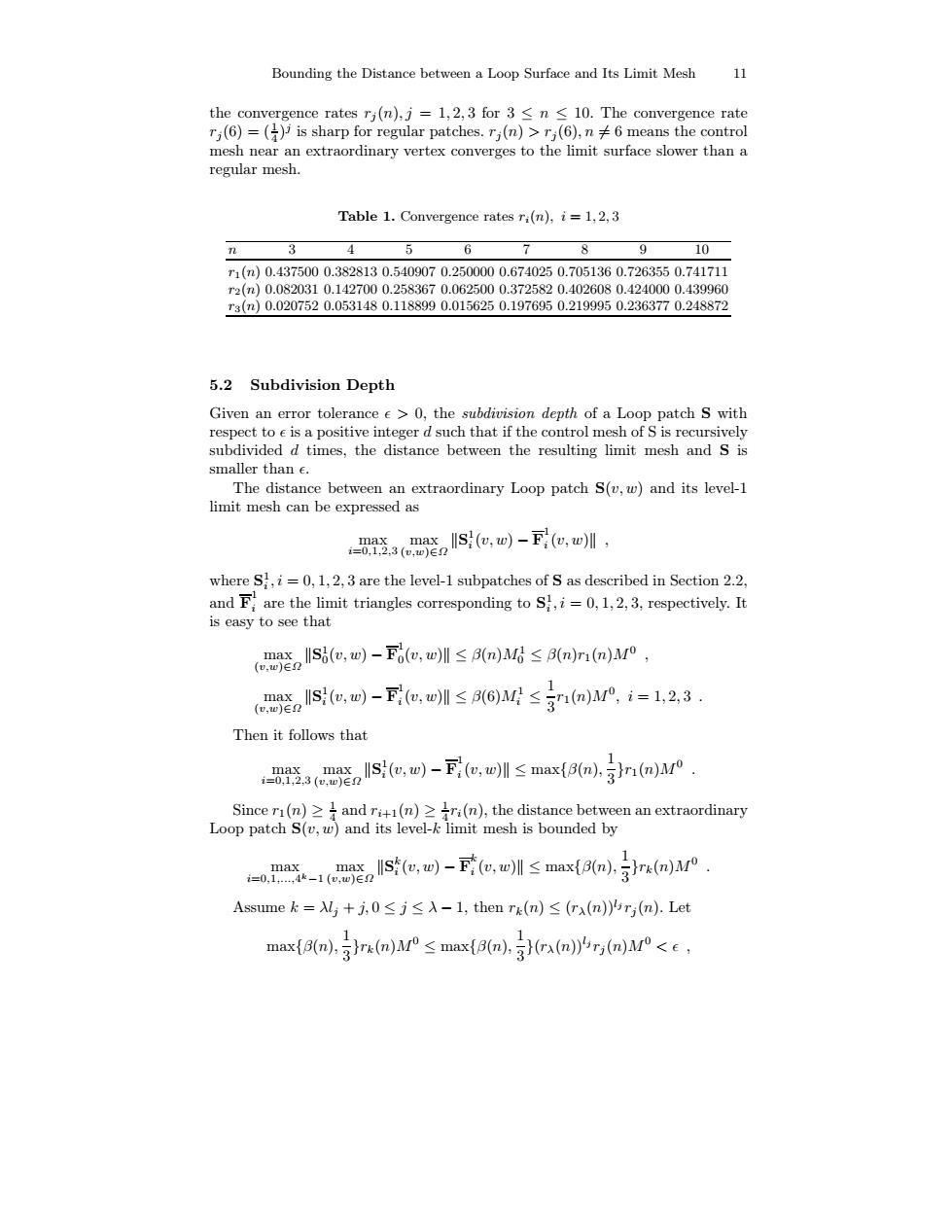正在加载图片...

305400702500000.87400507051380.7 a7417 5.2 Subdivision Depth iven an 置elIS,w-Ete,wn ()-Fi(c.))m(n)ap fe1seo中ra ma.。uaaa -s1e整,-或te.)5 max3o.jrnia Amk-+i0jS-l,由m(例s(r,a.L max)(5 m()r Bounding the Distance between a Loop Surface and Its Limit Mesh 11 the convergence rates rj (n), j = 1, 2, 3 for 3 ≤ n ≤ 10. The convergence rate rj (6) = ( 1 4 ) j is sharp for regular patches. rj (n) > rj (6), n 6= 6 means the control mesh near an extraordinary vertex converges to the limit surface slower than a regular mesh. Table 1. Convergence rates ri(n), i = 1, 2, 3 n 3 4 5 6 7 8 9 10 r1(n) 0.437500 0.382813 0.540907 0.250000 0.674025 0.705136 0.726355 0.741711 r2(n) 0.082031 0.142700 0.258367 0.062500 0.372582 0.402608 0.424000 0.439960 r3(n) 0.020752 0.053148 0.118899 0.015625 0.197695 0.219995 0.236377 0.248872 5.2 Subdivision Depth Given an error tolerance ǫ > 0, the subdivision depth of a Loop patch S with respect to ǫ is a positive integer d such that if the control mesh of S is recursively subdivided d times, the distance between the resulting limit mesh and S is smaller than ǫ. The distance between an extraordinary Loop patch S(v, w) and its level-1 limit mesh can be expressed as max i=0,1,2,3 max (v,w)∈Ω kS 1 i (v, w) − F 1 i (v, w)k , where S 1 i , i = 0, 1, 2, 3 are the level-1 subpatches of S as described in Section 2.2, and F 1 i are the limit triangles corresponding to S 1 i , i = 0, 1, 2, 3, respectively. It is easy to see that max (v,w)∈Ω kS 1 0 (v, w) − F 1 0 (v, w)k ≤ β(n)M1 0 ≤ β(n)r1(n)M0 , max (v,w)∈Ω kS 1 i (v, w) − F 1 i (v, w)k ≤ β(6)M1 i ≤ 1 3 r1(n)M0 , i = 1, 2, 3 . Then it follows that max i=0,1,2,3 max (v,w)∈Ω kS 1 i (v, w) − F 1 i (v, w)k ≤ max{β(n), 1 3 }r1(n)M0 . Since r1(n) ≥ 1 4 and ri+1(n) ≥ 1 4 ri(n), the distance between an extraordinary Loop patch S(v, w) and its level-k limit mesh is bounded by max i=0,1,...,4k−1 max (v,w)∈Ω kS k i (v, w) − F k i (v, w)k ≤ max{β(n), 1 3 }rk(n)M0 . Assume k = λlj + j, 0 ≤ j ≤ λ − 1, then rk(n) ≤ (rλ(n))lj rj (n). Let max{β(n), 1 3 }rk(n)M0 ≤ max{β(n), 1 3 }(rλ(n))lj rj (n)M0 < ǫ